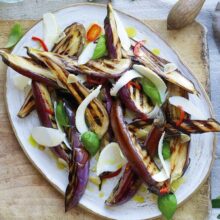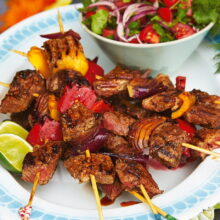How to Grill Steak at Home

If you’re looking for a satisfying, flavorful meal you can cook in a short amount of time, then grilling steak is an easy option. With a few tips, you’ll be able to enjoy the best beef steak every time.
The key to achieving a deep-brown, crispy crust is eliminating as much moisture from the surface of the meat as possible. The Maillard reaction, which turns the proteins into a deliciously crisp exterior, is slowed by water.
Tips
If you want to grill steak at home, it’s important to know the basics of how to do it properly. The most important thing to remember is that a steak needs to be cooked at the right temperature in order for it to be tender and delicious.
To do this, use a meat thermometer to make sure it reaches the desired temperature. For medium-rare steak, you want an internal temperature of about 130 degrees; for medium, it’s 140 to 145 degrees; and for well done, it’s 160 degrees or higher.
Using a meat thermometer is also important to make sure the steak doesn’t overcook or dry out too much, especially for a thick cut. To check, insert the probe into the thickest part of the steak (avoiding the bone and fat).
For thin cuts of steak, such as skirt or fillet steaks, you should sear them over direct high heat until they reach their desired doneness. Flip them frequently for a golden-brown exterior and even cooking.
Ingredients
Grilling steak at home is so easy and incredibly satisfying! Just a few simple ingredients are all that’s needed, and a little time will yield tender and juicy steaks every time.
Steaks are a great way to use up leftovers or make dinner an occasion. They pair well with a variety of side dishes, including hearty salads and classic steakhouse sides.
The best steaks are made from prime cuts, which are produced from cattle that have high marbling levels for the most flavor. You can find these at the grocery store or your favorite butcher.
A steak marinade or seasoning is also a great way to enhance the flavor of your meat. I like to add soy sauce, lemon juice, olive oil, Worcestershire sauce, garlic and Italian seasoning to my marinade, but feel free to use your favorite ingredients.
I start steaks on the grill over high heat for 2 minutes per side to sear the outsides and create a delicious crust, then move them over to the cooler side of the grill for the rest of the cooking process. This is called 2-zone grilling, and it’s the key to tender, meltingly tasty grilled steaks.
Temperature
Steak is one of the most popular cuts of beef to grill at home. But cooking it can be difficult to master, especially when it comes to knowing the ideal temperature for your cut of meat.
A meat thermometer is the perfect tool to take the guesswork out of the equation and ensure that your steak is cooked properly. Use this handy chart below to determine the best cooking temperature for your desired level of doneness.
For rare steaks, the internal temperature should be 125 degrees Fahrenheit. For medium-rare, it should be 130 to 135 degrees and for well done, 155 degrees.
For a perfectly grilled steak, it’s important to sear the meat quickly over high heat to develop the Maillard reaction that creates a crust and seals in the juices. It also helps cook the steak to your desired doneness without burning the outside.
Time
If you’re looking for a steak that’s as tender and juicy as possible, you’ll want to take care with your grilling time. It’s important not to overcook the meat because it will lose its back tenderness.
Using a temperature probe or a meat thermometer is the best way to ensure that your meat is done at a safe internal temperature. Use a digital thermometer for a super accurate reading.
When you’re ready to remove the steak from the grill, insert the probe in the center of the thickest part and check for the desired level of doneness. For rare, 120 degrees is the ideal temperature; for medium rare, 130 degrees; and for medium, 140 degrees.
Once the steak is cooked to your liking, transfer it to a plate and cover loosely with foil to allow the juices to redistribute throughout the meat. Then let it rest for at least three minutes before cutting. This allows the juices to fully set and gives the meat a tender, juicy finish.


